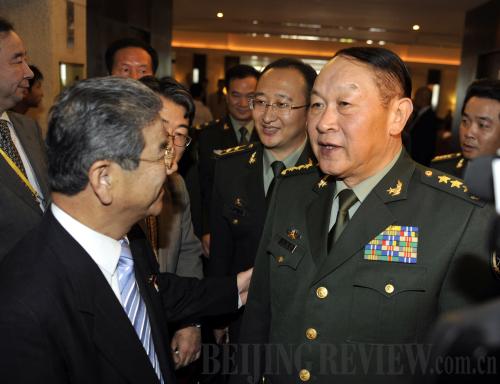|
 |
|
OVERCOMING DIFFICULTIES: Chinese Defense Minister Liang Guanglie (right) meets with his Japanese counterpart Toshimi Kitazawa on the sidelines of the first ASEAN Defense Ministers' Meeting Plus in Hanoi on October 11. The meeting could be seen as a sign that the two countries have tried to mend relations damaged by disputes over the Diaoyu Islands (HUANG XIAOYONG) |
The diplomatic row between China and Japan over the latter's illegal detention of a Chinese fishing boat was initially resolved on September 24 when Japanese authorities released the boat's captain. But its repercussions have yet to be fully addressed.
The Chinese Government and public protested strongly after Japanese coast guards captured the boat in waters off the Diaoyu Islands on September 7. Six days later, Japan freed all other crew members while keeping the captain in custody.
Right-wing Japanese forces staged their own demonstrations, accusing the authorities of "showing weakness to China." Relations between the two Asian neighbors hit a low point.
Managing disputes
The Diaoyu Islands, which sit on the eastern edge of the continental shelf in the East China Sea, have been Chinese territory since the early Ming Dynasty (1368-1644). Both the Ming Dynasty and the ensuing Qing Dynasty (1616-1911) exercised jurisdiction over the islands.
Japan took control of the islands during the Sino-Japanese War of 1894-95, which China lost, and placed them under the jurisdiction of the Okinawa Prefecture. In 1943, the United States, Britain and China issued the Cairo Declaration, which stated Japan should return all occupied Chinese territories, including the Diaoyu Islands. The provisions were later reaffirmed in the Potsdam Declaration of 1945, which called for Japan's surrender in World War II. Japan accepted the terms of the declaration the same year.
In 1951, however, Japan and the United States signed the San Francisco Treaty, under which the Diaoyu Islands, along with Okinawa, were put under U.S. administration. When it returned Okinawa in 1972, the United States handed the "administrative rights" of the Diaoyu Islands to Japan, as well. It used that term, rather than "sovereignty," due to Chinese protests.
Given the complex history, it is no wonder that disputes often arise over the Diaoyu Islands. For instance, a number of Chinese fishermen sailed to waters off the islands in 1978, while displaying the slogan, "The Diaoyu Islands are Chinese territory." Japanese officials complained to the Chinese Embassy in Japan. The embassy replied that Chinese fishermen have the right to operate in those waters because the Diaoyu Islands are part of China. Despite the friction, that year China and Japan signed a landmark document: the Sino-Japanese Treaty of Peace and Friendship.
In 1990, Seinensya, a right-wing Japanese organization, erected a lighthouse on one of the islands, drawing protests from China. Seven Chinese activists landed on the islands in 2004 to demonstrate sovereignty. Members of the Japanese right wing also wanted to follow suit, but the Japanese Government would not allow it. Two years later, Japanese authorities arrested fishermen from China's Taiwan Province off the Diaoyu Islands. The fishermen were soon given an apology and released.
Clearly, China and Japan have long been at odds over the Diaoyu Islands. Their conflicting claims, however, have not taken a dramatic toll on overall Sino-Japanese relations. Disputes over the Diaoyu Islands are manageable.
In the latest clash, Japan tilted the balance by arresting the Chinese captain and handling the case in accordance with domestic law. The move was closely related to the changing dynamics in the East China Sea. The United States interfered in regional affairs following the sinking of the South Korean warship Cheonan in March. It has held a series of joint military exercises in the region, causing tensions in China's neighborhood. Japan may have attempted to capitalize on this delicate situation.
Moreover, the incident occurred shortly before the party chief election for Japan's ruling Democratic Party. Ichiro Ozawa, a staunch opponent of incumbent Prime Minister Naoto Kan, courted voters by saying the Diaoyu Islands have never been part of China. To compete with Ozawa, Kan adopted a hard-line stance toward China, detaining the Chinese fishermen.
The move could also be a way to feel China out. In August, Japan nationalized 25 outlying islands to use as base points in territorial sea demarcation in order to gain access to vast resources under the sea. Since its interception of the Chinese fishing boat met with vehement reactions from China, Japan will likely avoid further provocation.
| 